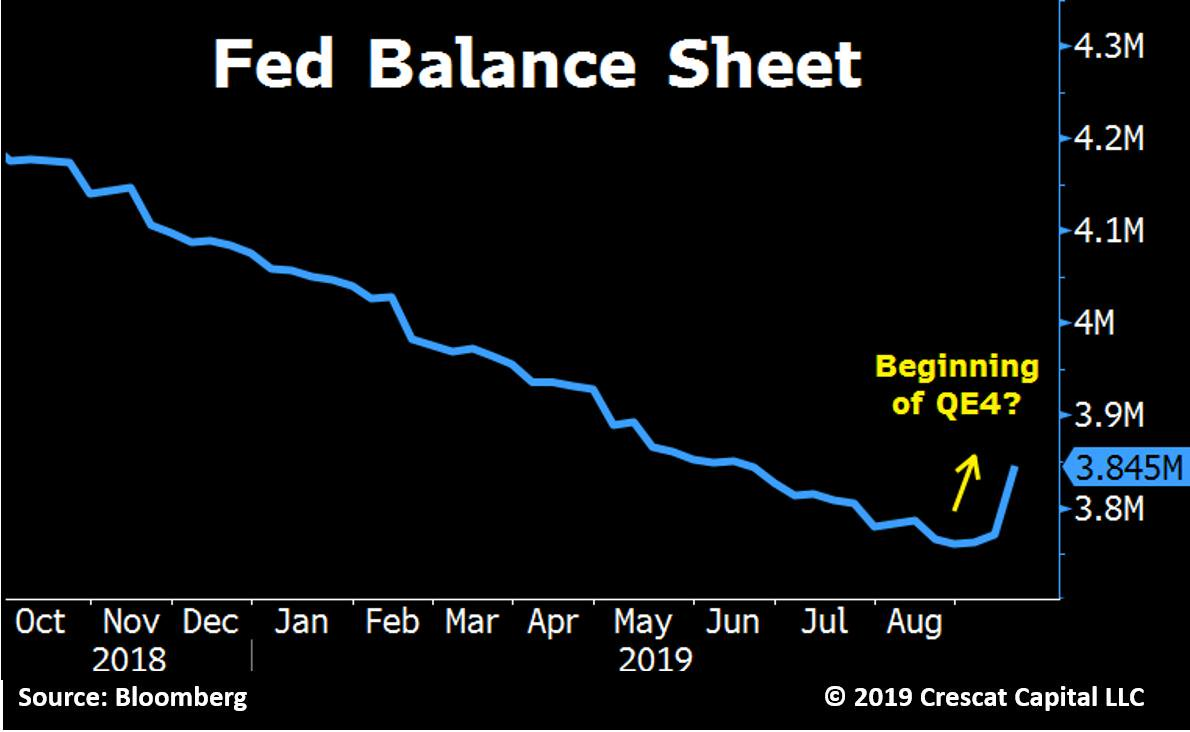
NY Fed Boosts Overnight Repo Operation To At Least $120 Billion Starting Today
Don’t tell anyone, but the Federal Reserve has initiated its 4th round of quantitative easing, the first since the ‘Great Recession’ a decade ago. During the last day of the Fed’s two day meeting on September 25, Federal Reserve chairman Jerome Powell said he expected the economy to expand at a more moderate pace, and that there may be need to resume balance sheet growth sooner than expected.
Powell then went on to say that the views of interest rates have ‘changed significantly’. Knowing what the data says about how geopolitical events, and other events, are going to evolve over the next 90 days, and the implications to the economy this year, there is a lot of uncertainty, but we should expect the job market to remain strong.
While the Federal Reserve will be conducting funding operations to resume its balance sheet expansion in response to low bank reserves, Chairman Powell wanted to make sure that the current funding operations are not seen as quantitative easing. Although it may look and sound a lot like what pulled the economy out of the financial crisis, this time around will be different.
During the 2008 credit crisis, the Fed’s quantitative easing program included buying assets to pull the economy out of the ‘Great Recession’. This time the program is looking to meet demand for cash as it tries to calibrate the proper level of bank liquidity by conducting overnight repurchase, or repo, operations. This ensures that funding for overnight loans stays constant, and the fed funds rate trades within its targeted range of 1.75%-2%.
It’s been 11 years since the height of the credit crisis when this process was last implemented. Powell described it as “organic,” rather than QE4, or a fourth round of QE.
What We Don’t Want
In normal economic times, periods of growth and business cycles have always been followed by ‘healthy recessions’, but the Central Bank and the government’s interference has all but eliminated that process.
In the past, recessionary phases and economic downturns have always been part of the economic cycles for rebuilding the economy, this includes stock market corrections during times of excess. Instead of allowing the economic downturns, the Central Bank basically prints money to expand its balance sheet through asset purchases in response to low bank reserves. Exactly what Japan did in 1995 when it started quantitative easing programs to write off more than 50.8 trillion Yen in bad bank loans.
Between March 2001 and December 2004, Japanese banks took in more than 3.35 trillion Yen in liquidity injections as they targeted long term government bonds purchases, which lowered yields on assets. Japan’s bubble burst between 1989 and 1990 when the BOJ raised interest rates from 2.5% to 6%, which triggered the once robust economic growth to slow down significantly.
When the recovery proved slow, Japan turned to Keynesian remedies: printing money, lowering interest rates and increasing the government deficit. After a series of rate cuts left the discount rate at 0.50%, Japan aggressively attempted nine stimulus programs that totalled 140.5 trillion Yen, or $1.3 trillion, and there was still no recovery.
By 1997, the Japanese economy was reeling from slow growth, a high level of bank loans and low interest rates, yet, like the U.S. Central Bank today, it was not called QE. Then, the BOJ decided to help the smaller banks, and bought trillions of Yen in commercial paper between October 1997 and October 1998. While some growth did recover between 2002 and 2007, it vanished during the Great Recession.
After another round of QQE in 2013, monetary policy failed to work. The negative effect of debt, QE and QQE, have caused Japanese debt to soar. According to a 2015 report by well known hedge fund manager Ray Dalio, Japan’s real debt burden, including private debt, relative to its GDP was around 449%, and ranked 19th out of the 20 countries he measured. This directly reduced the potential for savings or investment, which in turn limited future economic growth and current returns.
Certainly, we do not want to see the U.S. where Japan is today, but debt is piling up, and paying it down is only going to get harder and harder. As of today, Japan’s total national debt sits at over $9 trillion dollars and continues to rise.
In the end, the world’s debt rose by $3 trillion in the first quarter of 2019, unprecedented borrowing that has pushed total global debt to $246.5 trillion. The U.S. debt clock is now nearing $23 trillion (https://www.usdebtclock.org/). While some will say that the feds overnight repo program is not QE4, it is essentially doing the same thing it did during the 2008 credit crisis, racking up debt while adding liquidity to underfunded bank balance sheets.
As the Fed prepares to lower rates next week, one has to wonder what tools it will have during the next economic downturn. In 2007, before the credit crisis started, I remember being at my desk in the S&P’s when the PitBull told me that there was ‘rotten wood’ floating around in the markets leading stocks, brokerage firms and banks.
What unfolded over the next few years? A stock market crash, Bear Stearns and Lehman blowing up and all the index arbitrage sell programs I did for UBS, it was almost surreal. I remember the S&P 500’s “Satanic Lows” at 666, and the 300% rally that ensued over the next 10 years. I just don’t think the next credit crisis will be like the last one. I worry that that the next one could start as a liquidity crisis exactly where the fed is concentrating its sights; the overnight repo market.
Only time will tell…
